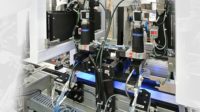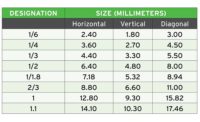Successful system integrators display common traits and practices. Whether you are a system integrator (SI) or an end-user, knowing the qualities that make a SI successful can really make a difference in your business.
First, let’s define the term. A SI is an enterprise that takes an end-user’s requirement for a piece of equipment, determines what components are needed to meet the requirements, constructs an assembly that combines the components correctly, and adds some value through programming the application requirements. While the SI does innovate and to some limited extent experiment, most do not invent or provide R&D services. Of course, there are exceptions where certain system integrators will tackle some R&D if it’s relevant to a potential project for them.
Usually the SI is an independent company serving many end-users. However, there are some larger end-user companies with a department dedicated to designing and building manufacturing equipment exclusively for their company’s use. This department is still a SI, but with a restricted market.
Some system integrators are exclusively machine vision integrators. They supply the camera, optics, lighting, processor, software, and interfaces to external equipment along with the mounting for the components, but they do not supply material handling, such as a conveyor, or any other process equipment. Other machine vision system integrators supply a turnkey system consisting of the machine vision system along with associated part handling equipment. Still others take on more complex projects involving processes outside of machine vision such as assembly, packaging, welding, or robotics.
System integrators often differentiate themselves by focusing on certain industries. One system integrator might specialize in medical devices where another system integrator specializes in food processing and yet another specializes in the automotive industry.
The reasons an end-user comes to a SI is twofold. First, they cannot find any commercial piece of equipment to meet their needs. Second, they recognize to undertake designing and building the equipment takes resources they do not have and entails risks beyond what they are comfortable with. What the SI brings to the project is resources and the ability to manage the risks. Let’s discuss risk first and then return to resources.
Managing Risks
What are large risks for the end-user are smaller risks for the SI. The effective SI brings specialized skills to the project. These skills include knowledge of and experience with machine vision technology that reduces risk and an excellent ability to manage risk so the adverse impact is minimized.
Doug Putnam-Pite of Owens Design Inc., Troy Kreger and Chris Martin of Verselus LLC, and David Dechow of Fanuc Robotics, all people highly experienced in machine vision system integration, agree risk is the primary reason end-users seek the services of a SI.
Risks are inherent in business and especially inherent in any engineering activity such as system integration. The chief mitigators of risk are knowledge and experience. This knowledge and experience of machine vision technology and its application must be a key attribute of the effective machine vision system integrator. The second component in dealing with risk is a process to identify and manage risks. While failure is never a good thing, then the saying, “If you’re going to fail, fail fast and cheap,” applies. The SI should have a process for quickly identifying and dealing with risks.
Dechow recommends the first step in managing risk is to have a comprehensive requirements document. This echoes a quote by Charles Kettering, “A problem well described is a problem half solved.” End-users range in their ability to convey requirements from being quite comprehensive to providing only a cursory statement of the objective. The SI and the end-user must partner in creating a comprehensive specification. Here, the SI’s knowledge of machine vision can insure necessary requirements are identified and specified.
The well written specification notes not only what is required, but in many cases what is not required. Dechow relates a common conversation late in the project where the end-user says, “It doesn’t have or do ….” To which the SI responds, “You never told us that was needed.” Followed by the end-user saying something like, “You never asked,” or “That’s standard practice in this industry; you should have known.”
Kreger and Martin explain how they begin the project by identifying the subsystems which will comprise the final solution. Along with that, they develop requirements documents for each subsystem. Then they extract from their “toolbox” of subsystems developed and proved out for prior projects those they can incorporate into the current project with minimal change. All other needed subsystems not in the toolbox they consider as posing some degree of risk. They plan and perform proof-of-principle (PoP) tests for each of those subsystems. Putnam-Pite also uses PoP as a means of early resolution of risks. If the PoP tests indicate unresolvable problems, then the end-user is engaged in discussion to see if the project should be continued with requirements modified to make the system feasible.
Skills and Resources
With few exceptions, end-users do not possess the resources to tackle any but a few relatively uncomplicated system integration projects. Resources consist of staff, skills, facility, and relationships. The size of the staff required depends on the complexity of the systems the SI undertakes and the number of projects the SI plans to handle at one time. A SI with only a few people can work successfully if they devote all their resources to one project at a time. Most SIs are equipped to handle multiple projects and their staffing levels correspond to the number of projects undertaken.
Having enough people is not sufficient. As a group, those people must have necessary skills. Skills often needed by a machine vision SI are:
- Optics
- Electronics
- Image processing
- Software development
- IT
- Mechanical
- Controls
- Motion control or robotics
- Process engineering
- Documentation
- Training
- Maintenance
- Project management
- Problem solving
The end-user usually has equal or superior skills and resources than a SI in some of these areas. For example, the end-user is usually more knowledgeable in process engineering as it relates to their products. A SI specializing in an industry usually develops almost equal process knowledge to that of the end-user. Many end-user organizations have a group providing high-caliber professional training. While this group is a resource, it does not possess the detailed knowledge of the specific integrated system. Most end-user organizations have a highly skilled maintenance staff on location. However, often this maintenance staff is not familiar with or equipped to maintain optics. And, again, the maintenance staff does not have the knowledge of the specific integrated system. With training, the maintenance staff can become effective at routine maintenance of a vision system. For more complex problems, the SI remains a crucial link in maintenance support.
The final component of resources is relationships with suppliers of machine vision components. By developing these relationships, the SI becomes familiar with their suppliers’ products and is well along on the learning curve. They have also developed channels with the suppliers to get assistance in solving challenges.
Project management is a critical skill for any SI since their business is based solely on projects. The effective SI can describe their project management work flow processes.
Things that Go Bump in the Night
Even a system integration project involving the most cooperative end-user working with the most competent SI can experience problems. Some of the common problems can be foreseen and avoided.
Lack of a good specification
The specification is the key communication document. In principle, this is communication that flows from the end-user to the SI. In practice, it is best developed by the end-user and refined jointly with the SI to help make sure all relevant information is documented. In most instances, the initial specification has missing information, but with collaboration on the specification’s refinement, it becomes the foundation of a successful project. It can be just as important to let the SI know what is not important as what is important. Omission of relevant facts from the specification is understood by the SI to mean the missing information is irrelevant.
Changing requirements or specification creep
Although undesirable, it is common for requirements to change during the project. There may be a fundamental change to the product or the process or to the incoming raw materials. These changes to the product or process must be accommodated even though it means a change in scope that certainly affects cost or time or both.
A very common occurrence is specification creep. This is often caused not by changes to the product, process, or materials, but by a growing awareness by the end-user’s staff of the potential of machine vision and a desire to extract even greater value from the finished system. Part of the SI’s job is to educate the end-user about the triple constraint of project management: scope, time, and resources. If you change one (i.e., scope) one or both of the other two constraints must necessarily change.
The most common way a SI can help avoid specification creep is to deliver quickly.
Acceptance criteria
A key question in any project is, “How do we know when it’s done?” This is the purpose of the acceptance test procedure. It lets the end-user know if the system is adequate. It also lets the SI know when the system is functioning adequately or whether more refinement is necessary.
Suitable samples
After the specification, having sample parts covering the full spectrum of conditions is the next most important communication technique between the end-user and the SI. Despite what is written and what appears on drawings, the samples are the only way the SI can really tell what is imaged and how to analyze the image.
It is very important the samples be actual parts representing actual manufacturing conditions. Parts created with artificial attributes, such as simulated defects, very rarely reflect what the vision system will encounter in actual production. This requirement brings up the conundrum for when the end-user orders a vision system for a new production line, and real production parts are not available. In this case, both the end-user and the SI must agree the final development work will take place after real parts are available and this might be after the system is installed.
A positive test for an adequate set of samples is: will the end-user be willing to accept the system as meeting specifications based only on the samples supplied to the SI? If not, the sample set is not adequate.
Workload fluctuations
The SI doesn’t work in a well-controlled market. Also, the SI cannot inventory unused engineering hours. The result is fluctuations of the SI’s workload. It is very easy for the SI to become overcommitted and unable to devote adequate resources to all the projects they are working on. The effective SI has resources such as contract employees or consultants they can bring in when the workload peaks.
Conclusion
The SI recognizes the end-user is transferring risk, and to truly be effective, the SI needs to be effective in identifying and managing risk. The SI must offer outstanding skills that cover a wide gamut and be able to assemble the resources needed by their workload. And finally, the SI must be alert to conditions that adversely affect the project, and work with the end-user to see these are avoided or at least handled in the best way possible.


